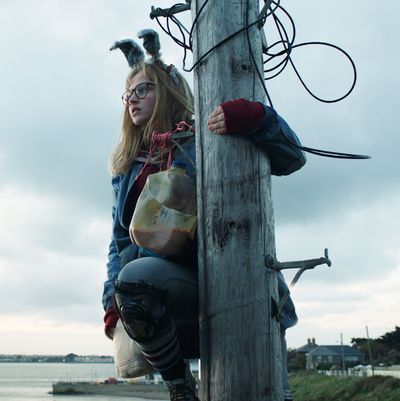
I Kill Giants feels secret and dangerous, like a VHS tape dug out of a dusty crate at a yard sale; itÔÇÖs the kind of movie you ended up watching every week as a kid just because of how weird it made you feel. The debut feature of director Anders Walter is based on the graphic novel of the same name by Joe Kelly (who also adapted the screenplay), and itÔÇÖs at once familiar and unsettling, with shades of PanÔÇÖs Labyrinth and Return to Oz. But what gives it its chills has less to do with its freaky creatures, and more with the troubled state of its young heroine. Young protagonists escaping into fantasy in the face of traumatic reality is a common theme in childrenÔÇÖs fiction, but few films take their heroineÔÇÖs mental state seriously enough to interrogate it the way I Kill Giants does.
Barbara Thorson (Madison Wolfe) is a wild, moody tween living with her older sister and brother in a state of not-quite-controlled chaos on windswept Long Island. Their parents are absent, for reasons that will come to light over the course of the film. BarbaraÔÇÖs sworn duty is that of a giant slayer; she goes about her business setting traps and creating anti-monster potions to protect the town from a threat they remain blissfully unaware of. Never without a battered pair of rabbit ears (in tribute to her ÔÇ£spirit guideÔÇØ) sheÔÇÖs a little rain cloud at home despite her sister KarenÔÇÖs (Imogen Poots) attempts to bond with her, and sheÔÇÖs ostracized and friendless at school. A new girl (Sydney Wade) arrives and is drawn to her eccentricities, and a school counselor (Zoe Saldana) tries to break through to her, but BarbaraÔÇÖs zealousness proves very effective at keeping people out.
The film works largely because of Wolfe, a fierce and fearsome young actor who is able to capture BarbaraÔÇÖs hurt and anger while never coming off as beyond her years. ThereÔÇÖs something extremely recognizable about this girl ÔÇö just about too old to still be playing pretend, but so willing to dig into her outcast status ÔÇö whether you were her growing up or remember her from school. The reality of BarbaraÔÇÖs ÔÇ£professionÔÇØ is kept gently ambiguous for the first half of the film; we catch a glimpse of a gnarled giant hand in the filmÔÇÖs opening minutes, but the beasts stay elusive until BarbaraÔÇÖs emotions start to unravel in earnest. To the degree that the film has been promoted at all, itÔÇÖs pushed Chris ColumbusÔÇÖs producing credit and attendant Harry PotterÔÇôadjacent ÔÇ£magic,ÔÇØ but itÔÇÖs much more strategic and impressionistic about its use of effects ÔÇö for budget reasons, IÔÇÖm sure, but also because of the deeply subjective origins of its titular giants.
The reason behind BarbaraÔÇÖs fantasy life, when revealed, will work better for some than others. WhatÔÇÖs undeniably impressive, however, is how the film never tries to assert that the way Barbara has handled her trauma is the way all kids would. The heroine of I Kill Giants is an extremely specific and complicated girl, and the film is very explicitly about her grief, not all grief. ThereÔÇÖs more than enough material there, as it turns out.
With its bunny ears and underlying Phillies obsession and perfectly art-directed secret hideouts, I Kill Giants could have easily run the risk of becoming too precious for its own good. But itÔÇÖs too dark and strange a film to ever be accused of being cute. ThereÔÇÖs a radical energy running through it, partly due to the fact (which I realized very late into the film) that virtually all its speaking characters are women; all its conflicts and bonds are between girls and sisters and teachers and friends. Nothing is fixed by the filmÔÇÖs end, but a few things have been confronted and faced down. This is a film that is going to mean a lot to a certain kind of kid, whether they dig it out of a dusty yard-sale crate or out of an on-demand queue.

